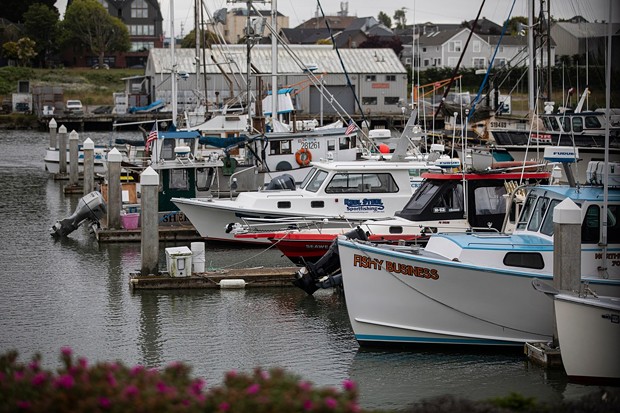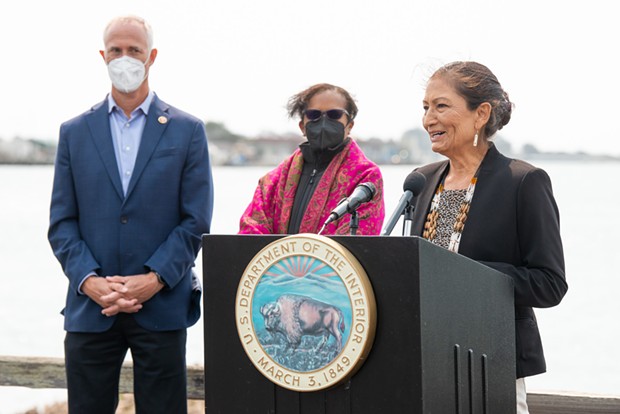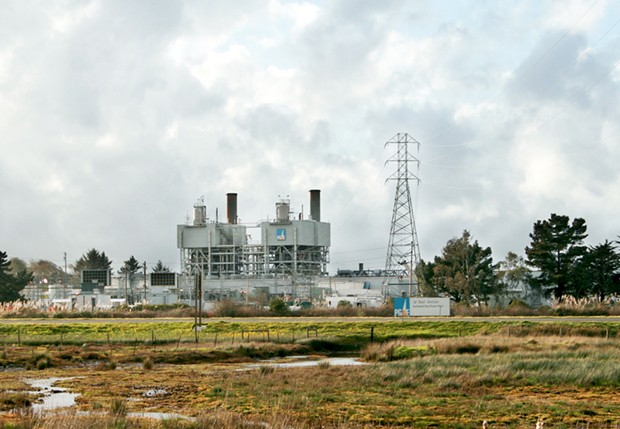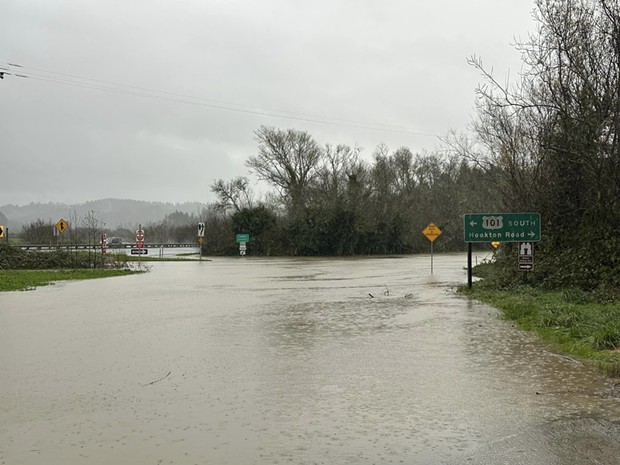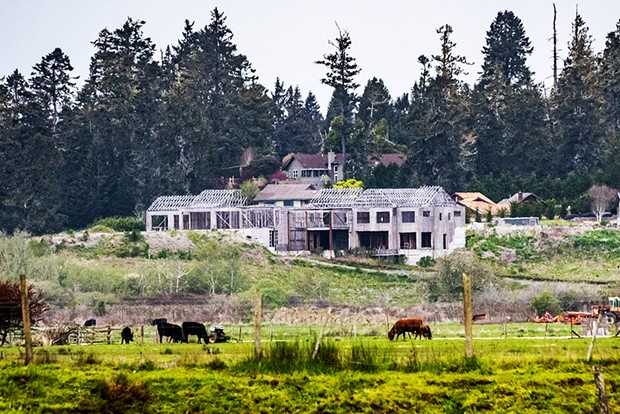Environment / Natural Resources
Monday, April 15, 2024
California Salmon Fishing Banned for Second Year in Row
Posted By Rachel Becker/CalMatters on Mon, Apr 15, 2024 at 11:27 AM
The April 10 decision is designed to protect California’s dwindling salmon populations after drought and water diversions left river flows too warm and sluggish for the state’s iconic Chinook salmon to thrive.
Salmon abundance forecasts for the year “are just too low,” Marci Yaremko, the California Department of Fish and Wildlife’s appointee to the Pacific Fishery Management Council, said last week. “While the rainfall and the snowpacks have improved, the stocks and their habitats just need another year to recover.”
State and federal agencies are now expected to implement the closures for ocean fishing. Had the season not been in question again this year, recreational boats would likely already be fishing off the coast of California, while the commercial season typically runs from May through October.
In addition, the California Fish and Game Commission will decide next month whether to cancel inland salmon fishing in California rivers this summer and fall.
The closure means that California restaurants and consumers will have to look elsewhere for salmon, in a major blow to an industry estimated in previous years to be worth roughly half a billion dollars.
“It’s catastrophic,” said Tommy “TF” Graham, a commercial fisherman based in Bodega Bay who now drives a truck delivering frozen and farmed salmon and other fish. “It means another summer of being forced to do something you don’t want to do, instead of doing something you love.
Tuesday, March 26, 2024
Huffman, Haaland to Visit Humboldt Bay Amid Growing Tribal Offshore Wind Opposition
Posted By Thadeus Greenson on Tue, Mar 26, 2024 at 1:21 PM
Reached this morning to ask about growing tribal opposition to federal plans to build a floating, deep water wind farm 21 miles west of Humboldt Bay — the latest of which came from the Trinidad Rancheria — Huffman said he remains committed to both pushing offshore wind forward but addressing tribal concerns, believing the two are not mutually exclusive.
“I don’t support a project that runs roughshod over tribes, the environment or any of our other values,” Huffman told the Journal. “The reason I support this offshore wind project is because it can be done in a way that I think supports those values and, really, enhances them. I think this is more a conversation about how to do this project rather than whether to do this project.”
Huffman’s comments came a day after the Trinidad Rancheria issued a press release announcing its tribal council had approved a resolution officially opposing offshore wind, making it the third local tribe to do so, along with the Bear River Band of the Rohnerville Rancheria and the Yurok Tribe. In the release, the Trinidad Rancheria also expressed support for the resolution passed by the National Congress of American Indians in February calling on the Department of the Interior and the Bureau of Ocean Energy Management to halt all scoping and permitting activities for offshore wind until completion of a transparent process “adequately protecting tribal environments and sovereign interests” is developed and implemented.
Thursday, March 21, 2024
UPDATE: Humboldt Community Services District Lifts Boil Advisory
Posted By Thadeus Greenson on Thu, Mar 21, 2024 at 4:43 PM
The Humboldt Community Services District has lifted the boil advisory issued yesterday in several local areas due to a burst main.
“The Humboldt Community Services District Public Water System in conjunction with the State Water Resources Control Board has determined that, through abatement of the health hazard and comprehensive testing of the water, your water is safe to drink,” reads an cancellation notice sent this afternoon. “It is no longer necessary to boil your tap water or for you to consume bottled water.”
See the full notice at the bottom of our original post.
PREVIOUSLY:
The Humboldt Community Services District is advising customers in the areas of Mitchell Road, Myrtletown, Ryan Slough and Freshwater that they should use boiled or bottled water for drinking and cooking until further notice.
The problem stems from a transmission main break near Indianola and Old Arcata roads in the city of Eureka’s system, which supplies some water to the community services district, on the evening of March 20. After the transmission line failure, the district was notified around 1 p.m. today that “some cloud water” may have been delivered into its system and that it could possibly contain mineral deposits and soil from the area where the breakage occurred.
As a result, the community services district has issued a boil advisory “out of an abundance of caution” to ensure the “health and wellbeing” of the community, according to its notice.
“We have been testing our water quality and flushing the affected areas,” the district’s notice states. “We have found no evidence of contaminated water within our system. We will continue to monitor and test our water quality for the next three days. If we discover any contamination, we will be reaching out to notify you. If we do not encounter any contaminated water, we will be reaching out to lift the Boil Water Advisory.”
Until further notice, residents in affected areas are advised that before drinking water from the system or using it for cooking they should first bring it to a rolling boil, let it boil for one minute, then let it cool before use. Alternatively, they can use bottled water.
The district anticipates the issue to be resolved within three days.
Tuesday, March 19, 2024
California is not Close to Meeting its Climate Change Mandates
Posted By Alejandro Lazo/CalMatters on Tue, Mar 19, 2024 at 10:05 AM
California will fail to meet its ambitious mandates for combating climate change unless the state almost triples its rate of reducing greenhouse gases through 2030, according to a new analysis released last week.
After dropping during the pandemic, California’s emissions of carbon dioxide, methane and other climate-warming gases increased 3.4 percent in 2021, when the economy rebounded.
The increase puts California further away from reaching a target mandated under state law: emitting 40 percent less in 2030 than in 1990 — a feat that will become more expensive and more difficult as time passes, the report’s authors told CalMatters.
“The fact that they need to increase the speed of reduction at about three times faster than they’re actually doing — that does not bode well,” said Stafford Nichols, a researcher at Beacon Economics, a Los Angeles-based economics research firm, and a co-author of the annual California Green Innovation Index released today.
“As we get closer to that 2030 goal, the fact that we’re further off just means that we have to decrease faster each year.”
Friday, March 8, 2024
The Klamath River Salmon Die-off Was Tragic. Was it Predictable?
Posted By Rachel Becker/CalMatters on Fri, Mar 8, 2024 at 8:32 AM
A recent large die-off of young salmon released into the Klamath River shocked and dismayed state biologists, reinforcing that human efforts to restore nature and undo damage can be unpredictable and difficult to control.
The tiny Chinook salmon turned up dead downriver just two days after they were released from the California Department of Fish and Wildlife’s brand new Fall Creek Fish Hatchery, built to supply the Klamath River as it undergoes the largest dam removal in history.
The $35 million state hatchery, on a tributary just upstream of Iron Gate dam in Siskiyou County, was constructed to help the river’s threatened coho and dwindling fall-run chinook salmon, a mainstay of commercial and recreational fishing and tribal food supplies.
The hatchery’s first release ended with an unknown number of the 830,000 young Chinook salmon found dead, their eyes bulging, in a federal sampling trap about 9 miles below the dam.
State officials called it “a large mortality,” but said there’s no official count yet and released no additional details about the size of the die-off.
California’s fish and wildlife officials said they suspect “gas bubble disease,” a condition similar to decompression sickness in scuba divers, is to blame — likely caused when the salmon traveled through a 9-foot-wide tunnel out of Iron Gate dam to reconnect with the Klamath downriver.
Gas bubble disease in fish is caused by “environmental or physical trauma often associated with severe pressure change,” officials said.
Jason Roberts, inland fisheries program manager with the state agency, said it’s an outcome that state, federal, and tribal scientists involved in the decision didn’t anticipate.
“The basin co-managers made the best decision they could with the information that they had, and unfortunately, it did not go well,” Roberts said. “I don’t think anyone thought water going through this tunnel would cause gas bubble disease, or we obviously wouldn’t have done it.”
Monday, February 12, 2024
Legislators Unveil Measure to Ask Voters for $1 Billion Offshore Wind Bond
Posted By Alejandro Lazo/CalMatters on Mon, Feb 12, 2024 at 11:56 AM
The bill, if approved, would place a bond before voters aimed at helping ports build capacity to assemble, construct and transport wind turbines and other large equipment. Long Beach and Humboldt County have plans to build such expansion projects.
Port expansion is considered critical to the viability of offshore wind projects, which are a key component of the state’s ambitious goal to switch to 100 percent clean energy. The California Energy Commission projects that offshore wind farms will supply 25 gigawatts of electricity by 2045, powering 25 million homes and providing about 13 percent of the power supply.
The first step to building these giant floating platforms has already been taken: The federal government has leased 583 square miles of ocean waters about 20 miles off Humboldt Bay and the Central Coast’s Morro Bay to five energy companies. The proposed wind farms would hold hundreds of giant turbines, each as tall as a skyscraper, about 900 feet high. The technology for floating wind farms has never been used in such deep waters, far off the coast.
An extensive network of offshore and onshore development would be necessary. Costly upgrades to ports will be critical, along with undersea transmission lines, new electrical distribution networks and more.
Friday, February 2, 2024
Humboldt Cannabis Grower to Pay $750,000 for Violating State Water, Wildlife Regulations
Posted By Rachel Becker/CalMatters on Fri, Feb 2, 2024 at 10:48 AM
Of the total, $500,000 is a record penalty for a water rights violation in California. State officials say the violations by Joshua Sweet and the companies he owns and manages, Shadow Light Ranch, LLC and The Hills, LLC, continued for years and were “egregious,” damaging wetlands and other resources.
Under the settlement, Sweet will have to pay an additional $1 million if the remediation work outlined is not completed.
In a statement to CalMatters, Sweet said, “If the full penalty and remediation costs were due today it would take everything I own.”
“Although I will follow through with my end of the settlement, I do not believe this is fair or just, and I believe I have already suffered way too much,” Sweet, a licensed cannabis cultivator, said in the emailed statement.
“Even during our court-mandated settlement conference, they were asked why they would go after a small independent businessman with these type of enormous fines usually reserved for huge corporations that destroy ecosystems.”
In the settlement, Sweet agreed that “developing the properties in Humboldt County … resulted in violations of the California Fish and Game Code and the California water Code.”
“Although I will follow through with my end of the settlement, I do not believe this is fair or just, and I believe I have already suffered way too much.”
Joshua Sweet, Humboldt County cannabis owner
The companies’ 435 acres of land are part of the Emerald Triangle, where cannabis reigns. Springs and streams of the Bear Canyon Creek Watershed cross the land and eventually drain into the South Fork Eel River — a wild and scenic river that provides critical habitat for threatened and endangered species of steelhead, Chinook and coho salmon.
The settlement comes as the cannabis industry is still trying to find its footing after legalization, and as its water use, especially for illegal cannabis operations, becomes increasingly contentious.
The agreement, approved by the Humboldt County Superior Court and announced last week, is the culmination of years of inspections by state water and wildlife officials dating back to 2016, according to the timeline outlined in the initial complaint.
It “resolves violations … that include: the owner’s destruction of wetland habitat and stream channels; conversion of oak woodland to grow cannabis; and failure to … satisfy permitting requirements,” the state’s announcement of the deal said.
Yvonne West, director of the State Water Resources Control Board’s office of enforcement, said Sweet didn’t have authorization to divert water to the reservoirs and use it. Between 2017 and 2020, Sweet took about 16.2 acre-feet of water for three ponds, according to an email from the water board — approximately enough to supply about 49 households for a year.
“The ordered penalties are modest given the scope of damage, the length of time the site has been left unremediated and considering the unjust enrichment or benefit to Mr. Sweet from running a business for several years without going through the necessary permitting process,” said Jeremy Valverde, assistant chief counsel at the California Department of Fish and Wildlife, in an emailed statement.
Sweet and his businesses “for years resisted our attempts to cooperatively work on restoration and recovery of those resources, leaving formal enforcement as our only option,” said Joshua Curtis, the North Coast Regional Water Quality Control Board’s assistant executive officer.
Sweet said, though, that the case didn’t have to play out like it did. “Offers were made and denied,” he said. “There would be no settlement without their need to ‘make an example of me first’.”
The size of the penalty is notable because the water board has limited powers to enforce California’s arcane water rights system. A weeklong standoff during a drought, when ranchers pumped more than half of the Shasta River’s water in violation of state orders, netted a $500 per day fine that reached $4,000, or roughly $50 per rancher.
“The ordered penalties are modest given the scope of damage, the length of time…and considering the unjust enrichment or benefit to Mr. Sweet from running a business for several years.”
Jeremy Valverde, California Department of Fish and Wildlife
State lawmakers floated a bill last year that could triple the fines for water rights violations, though the bill has thus far stalled. And in 2022, a new law enhanced penalties for cannabis-related violations to $3,500 per day, though this took effect after then-Attorney General Xavier Becerra filed the complaint.
“This was an ongoing use by Mr. Sweet and the penalties are over an approximately four-year period for unauthorized diversion and use of water to support cultivation,” West said. “Five hundred dollars a day, multiple violations over a four-year period, does really add up. And then again we did have the additional types of violations at play here as well.”
The cannabis operation’s complex irrigation system came to state officials’ attention after Sweet notified the Department of Fish and Wildlife of plans to further develop the property in 2015, the 2020 complaint said.
Over the years, inspections by state agencies turned up “violations … for unlawful alteration of the bed, channel, or bank of a stream and … unlawful sediment discharge into waters,” the complaint said. They also turned up storage tanks and three storage ponds, two of which predated his ownership and one that, according to the complaint, Sweet had constructed despite the warning that it needed a permit.
The pond was in a location that “disturbs/inundates wetlands with a direct hydrologic connection and discharge to a … tributary to the South Fork Eel River,” the complaint says. “Additionally, the Property’s other ponds, multiple illegal stream crossings, and road-associated landslide discharge or threaten to discharge to unnamed tributaries of the South Fork Eel River.”
The pond is one of the reasons state officials considered the case egregious, West said. “We didn’t have the opportunity to review and catalog the status of that wetland or the benefits of that wetland before it was destroyed.”
Sweet, the grower, said the lengthy process “has caused so much undue and unnecessary strain, pain, and suffering on me and my health, my family, my friends, and this community.”
“I thought what I was following the law and had hired the proper professional team to abide by the myriad of requirements,” Sweet added. “My suffering does not end, and I will continue to struggle for the foreseeable future. Which is, I guess, what they wanted.”
Wednesday, January 31, 2024
Saving Salmon: Newsom Unveils Blueprint for Ending Decades-long Decline
Posted By Rachel Becker/CalMatters on Wed, Jan 31, 2024 at 11:39 AM
The blueprint calls for tearing down dams and improving passages for migrating salmon, restoring flows in key waterways, modernizing hatcheries to raise fish and taking other steps to help Chinook, coho, steelhead and other migrating fish.
“We’re doubling down to make sure this species not only adapts in the face of extreme weather but remains a fixture of California’s natural beauty and ecosystems for generations to come,” Newsom said in a statement.
Fewer than 80,000 Central Valley fall-run chinook salmon — a mainstay of the state’s salmon fishery — returned to spawn in 2022, according to the California Department of Fish and Wildlife. It’s a decline of nearly 40 percent from the previous year, and the lowest since 2009. Last year, all salmon fishing was canceled in California and much of Oregon due to low numbers projected to return from the Pacific.
The threats to California's salmon are many — dams that block migration, diversions that drain rivers, ocean conditions and climate change. And the effects of the decline are wide-ranging: loss of fishery jobs, impacts on tribes’ food security and cultures, no local supplies for restaurants and consumers, and more.
Many of the projects and solutions outlined in Newsom’s report are already underway, or under the direction of the federal government, tribes and conservation groups. Included are the historic demolition of four aging hydroelectric dams on the Klamath River, and reintroduction of endangered Sacramento River winter-run Chinook eggs to the McCloud River upstream of Lake Shasta.
Regulatory efforts include establishing minimum flows on the fiercely contested Scott and Shasta Rivers, and the long-delayed and controversial management plan for the Bay-Delta, the heart of the state’s water supply.
Some environmental groups called the plan a ploy to burnish Newsom's image after taking other steps that jeopardized salmon: his waiver of water quality requirements in the Delta that protect salmon, his support of a controversial pact with major water suppliers, and his backing of the Delta tunnel project, which the state’s environmental assessment warned could put salmon at risk.
Monday, January 15, 2024
UPDATE: Local Emergency Declared Due to Storm Damage
Posted By Kimberly Wear on Mon, Jan 15, 2024 at 3:04 PM
Humboldt County Sheriff William Honsal has declared a local emergency due to the “significant impact of floods” during this past weekend's storm, the first step toward being able to request state and federal assistance.
“Significant flooding of small creeks and streams, as well as main stem flooding of the Mad River began on Friday, Jan. 12,” a new release today states. “The extensive flooding resulted in numerous flood rescue operations, extensive damage to local infrastructure, including damage to numerous culverts, cracking, slip outs, and degradation of county-maintained roads, as well as damage to numerous private residences, businesses, and agricultural land; these impacts are exhausting and exceeding available county resources.”
Anyone who experienced damage is encouraged to work with their insurance to file claims, the release states, noting the local proclamation “does not guarantee individual or financial assistance for damages incurred during the flooding event.”
They are also asked to report damage to the Humboldt County Office of Emergency Services (OES) by filling out the January 2024 Flooding Damage Report form here. Those reports will be used to assess damage sustained across the county.
“Though the immediate response has subsided, Humboldt County Public Works crews are still actively engaged in conducting emergency road repairs, exploring options for alternative routes, and cleaning up storm and flood debris along public rights of way,” the release states.
Find the full release at the bottom of this post.
This weekend’s storm system dropped record amounts of rain on Saturday, pushing the Mad River to its highest levels in 60 years and closing down roadways across the county, including U.S. Highway 101 at two points, due to flooding.
How many people were displaced due to flooding, the locations of the areas worst hit and estimates for the extent of damage countywide were not immediately available from the county Office of Emergency Services but more information is expected tomorrow, according to Sheriff William Honsal.
“We are doing damage assessments right now for the lower Mad River areas,” he said in a text to the Journal. “There was damage to some homes, but mostly damage to roadways and infrastructure. We will get some preliminary numbers tomorrow and consider declaring a local emergency based upon the initial damage assessments.”
The Mad River peaked at 27.26 feet at 8:15 p.m. on Saturday, with surrounding areas from Blue Lake to Tyee City and the Arcata Bottoms being inundated as a result, according to the NOAA hydrologic prediction service.
Flood stage for the Mad River is 22 feet, with 24 feet considered moderate flood stage and 28 feet major flood stage.
In a social media post, OES described it as the “most significant flooding of the Mad River since 1964.”
Tuesday, January 9, 2024
Despite Coastal Commission Appeal, Schneider Mansion Demolition, Restoration Could be Complete by July
Posted By Thadeus Greenson on Tue, Jan 9, 2024 at 1:43 PM
The deal ratified by the commission in July would have seen Schneider avoid up to $3.6 million in fines for a long list of permit violations by tearing down his partially constructed, more than 20,000-square-foot home, removing up to 15,000 cubic yards of fill dirt brought to the property, returning it to its natural grade and gifting a portion of it containing a documented archeological site to a third party to be held for the three local area Wiyot tribes. But six months later, the structure’s graying skeletal framing remains at the foot of Walker Point Road, with the California Coastal Commission having appealed the county’s decision.
Schneider submitted a host of documents to the commission’s staff Friday – including surveying maps, restoration and monitoring plans, and aquatic resource declinations — needed before the commission schedules a full appeal hearing for the case.

